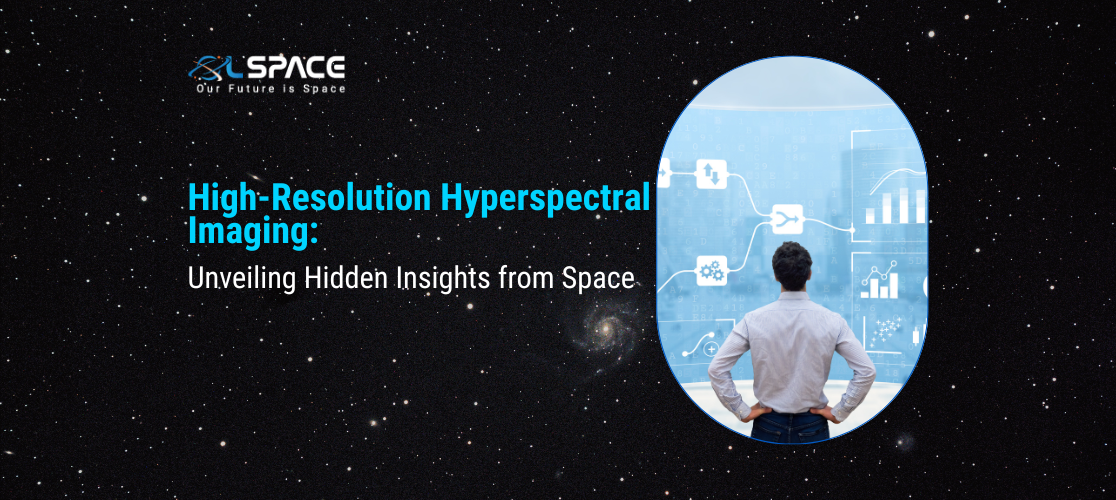05 April 2024
High-Resolution Hyperspectral Imaging: Unveiling Hidden Insights from Space

In the realm of remote sensing, high-resolution hyperspectral imaging represents a cutting-edge technology that offers unprecedented insights into Earth’s surface and its various phenomena. By capturing data across hundreds of spectral bands with exceptional detail, hyperspectral imaging enables scientists, researchers, and industries to unravel hidden insights and unlock a wealth of information from spaceborne platforms. This article explores the capabilities and applications of high-resolution hyperspectral imaging, highlighting its potential to revolutionise various fields.
1. Understanding Hyperspectral Imaging:
Hyperspectral imaging involves capturing images across hundreds of narrow, contiguous spectral bands, providing a comprehensive spectral signature for each pixel in the image. Unlike traditional multispectral imaging, which captures data across a few broad bands, hyperspectral imaging offers fine-grained spectral information, allowing for detailed analysis of Earth’s surface composition, properties, and changes.
2. Unparalleled Spectral Resolution:
High-resolution hyperspectral imaging systems can capture data with unparalleled spectral resolution, often spanning the visible, near-infrared, and shortwave infrared regions of the electromagnetic spectrum. This level of detail enables scientists to discriminate between different materials, identify specific chemical compositions, and detect subtle variations in surface properties.
3. Applications in Environmental Monitoring:
Hyperspectral imaging is widely used in environmental monitoring applications, including land cover classification, vegetation health assessment, and detection of environmental contaminants. By analysing the spectral signatures of vegetation, water bodies, and land surfaces, researchers can track changes over time, monitor ecosystem health, and assess the impact of human activities on the environment.
4. Mineral Exploration and Geological Mapping:
In the field of geology and mineral exploration, hyperspectral imaging is instrumental in identifying mineral deposits, mapping geological formations, and prospecting for valuable resources. The unique spectral signatures of minerals allow geologists to distinguish between different rock types, map alteration zones, and pinpoint areas with high mineral potential, aiding in exploration efforts.
5. Precision Agriculture and Crop Monitoring:
Hyperspectral imaging has applications in precision agriculture, where it is used to monitor crop health, detect nutrient deficiencies, and assess stress levels in plants. By analysing the spectral reflectance of crops, farmers can optimise irrigation, fertilisation, and pest management practices, leading to improved crop yields and resource efficiency.
6. Urban Planning and Infrastructure Monitoring:
In urban planning and infrastructure monitoring, hyperspectral imaging provides valuable insights into land use, urban development patterns, and infrastructure condition assessment. By analysing spectral data, city planners can identify land cover changes, monitor urban sprawl, and assess the condition of infrastructure assets such as roads, buildings, and utilities.
7. Disaster Response and Emergency Management:
Hyperspectral imaging plays a role in disaster response and emergency management by providing rapid, high-resolution data for assessing the extent of natural disasters such as wildfires, floods, and landslides. By capturing detailed spectral information, emergency responders can prioritise response efforts, assess damage severity, and plan recovery interventions more effectively.
8. Future Perspectives and Advancements:
As technology advances, the capabilities of hyperspectral imaging are expected to expand further, with improvements in spatial resolution, spectral range, and data processing algorithms. Future applications may include monitoring climate change impacts, tracking carbon sequestration, and supporting sustainable development initiatives on a global scale.
Conclusion:
High-resolution hyperspectral imaging represents a transformative technology that offers unparalleled insights into Earth’s surface and its dynamic processes. From environmental monitoring to mineral exploration, agriculture, urban planning, and disaster response, hyperspectral imaging has diverse applications across various sectors, contributing to scientific advancement, resource management, and informed decision-making. As hyperspectral imaging continues to evolve and become more accessible, its potential to unveil hidden insights from space and address pressing societal challenges will only continue to grow, shaping the future of remote sensing and Earth observation.
